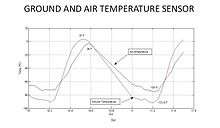Rover Environmental Monitoring Station
Rover Environmental Monitoring Station (REMS) is a weather station on Mars for Curiosity rover contributed by Spain and Finland.[1][2] REMS measures humidity, pressure, temperatures, wind speeds, and ultraviolet radiation on Mars.[3] This Spanish project is led by the Center for Astrobiology (Madrid) and includes the Finnish Meteorological Institute as a partner,[4][5] contributing pressure and humidity sensors.[4][6]

All sensors are located around three elements: two booms attached to the rover Remote Sensing Mast (RSM), the Ultraviolet Sensor (UVS) assembly located on the rover top deck, and the Instrument Control Unit (ICU) inside the rover. Goals include understanding Martian general circulation, microscale weather systems, local hydrological cycle, destructive potential of UV radiation, and subsurface habitability based on ground-atmosphere interaction.[4][5]
By August 18, 2012, REMS was turned on and its data was being returned to Earth.[2] The temperature at that time: 37 degrees Fahrenheit (2.8 degrees Celsius).[2] On August 21, 2012, one of two windspeedmeters returned data with errors. After testing it was concluded that it was broken, probably hit by a rock on descent.[7] Martian winds can still be detected with the other sensor.[7]
Reports are posted on the Center for Astrobiology website and twitter daily.[8][9]
See also
References
- ↑ Spain Supplies Weather Station for Next Mars Rover - Marsdaily
- 1 2 3 W. Harwood - Curiosity's Mars travel plans tentatively mapped - CBS
- ↑ "Rover Environmental Monitoring Station for MSL mission" (PDF). 4th International workshop on the Mars Atmosphere: modelling and observations. Pierre und Marie Curie University. February 2011. Retrieved 2012-08-06.
- 1 2 3 "MSL Science Corner: Rover Environmental Monitoring Station (REMS)". NASA/JPL. Retrieved September 9, 2009.
- 1 2 "Mars Science Laboratory Fact Sheet" (PDF). NASA/JPL. Retrieved June 20, 2011.
- ↑ Finnish technology lands on Mars - UUTISET
- 1 2 Materia - El sensor de viento español de 'Curiosity' se estropea (Google Translate)
- ↑ http://cab.inta-csic.es/rems/marsweather.html Center for Astrobiology
- ↑ https://twitter.com/MarsWxReport REMS on Twitter
External links
- CAB - REMS (Weather)
- NASA/JPL - REMS NASA Science Corner - REMS
- Temperature Pressure
- Materia - El sensor de viento español de 'Curiosity' se estropea
- Mars Weather - Twitter
|
|
